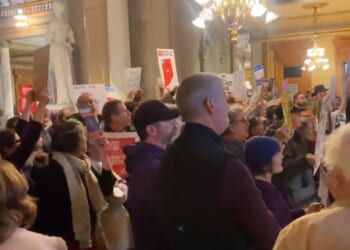
Under Governor Gavin Newsom, California has spent over $24 billion on housing and homelessness programs, even as the state’s homeless population reached a record high. The issue is sure to be an albatross around the governor’s neck in his inevitable bid for the White House. You might assume, therefore, that Newsom would be eager to take a new approach. You’d be wrong.
Last week, the governor stunned other Democratic policymakers by vetoing legislation that would have allowed jurisdictions to spend up to 10 percent of state housing dollars on abstinence-focused housing for people recovering from addiction. That means that every taxpayer dollar spent on reducing homelessness in California will continue funding Housing First programs, which let addicted residents consume methamphetamine, fentanyl, cocaine, alcohol, and other drugs without jeopardizing their housing status.
Finally, a reason to check your email.
Sign up for our free newsletter today.
California’s monolithic approach ignores the homeless population’s diverse needs. In severe economic downturns, such as the Great Depression, many homeless people are simply down on their luck and can find housing once they get a job. But when unemployment stands at historic lows, as it has in recent years, most homeless people have a range of non-economic problems, such as addiction and psychotic disorders. In the general population, the prevalence of substance-use disorder is more than triple that of serious mental illness. Likewise, while many seriously mentally ill homeless people have drug problems, the reverse is not true—i.e., for most addicted homeless people, the principle challenge is substance use.
Three decades ago, policymakers began changing their approach to helping seriously mentally ill homeless people. Instead of first attempting to get these individuals onto an antipsychotic medication and into regular meetings with a psychiatrist, for example, they insisted on providing “housing first.” This was a sensible approach for many of these individuals, because a psychotic person living in a cardboard box who believes the FBI is chasing him is not going to make it to weekly therapy sessions at a clinic.
Studies showed that while Housing First benefitted people with serious mental illness in some respects, it did not reduce substance use. One could reasonably argue that a formerly homeless person with schizophrenia who is now off the street and on antipsychotics is better off, even if he still drinks or uses drugs. But for the group of addicted homeless people without serious mental illness, substance use is not a secondary concern—it’s the overriding one. This is evident in San Francisco, where Newsom was once mayor. Multiple people die of overdose in Housing First settings each week, and the city has paid tens of millions of dollars to hotels used as housing sites during Covid-19 to repair the damage done by homeless residents, many with addiction-related issues.
In contrast to Housing First, recovery housing makes continued residence contingent on abstinence and fosters a sense of community among residents. Research shows that for people with substance-use disorders without a co-occurring serious mental illness, such housing increases abstinence and employment rates while lowering incarceration rates.
But in 2016, California passed a law requiring all state-funded homelessness programs to use the Housing First model. The state’s approach differed sharply from that of the Obama administration, which set aside 25 percent of federal Housing First dollars for housing that forbade alcohol and drug use. In California, “the groups”—for example, housing rights and drug legalization activists—pushed Democratic state policymakers to embrace an extreme agenda.
In 2024, Assemblymember Matt Haney (D) introduced a bill to return California to the Obama-era policy. (Full disclosure: I worked closely with his office on this bill and advocated for it in legislative hearings, briefings, and editorials.) The first version cleared the Assembly but died in the Senate. Haney, joined by Assemblymember Catherine Stefani, reintroduced a more modest proposal that would let jurisdictions receiving state homelessness funds use up to 10 percent for non-Housing First models.
That’s the bill that Newsom has vetoed. The question is why.
Pundits often attribute Newsom’s actions to his presidential ambitions, but that wouldn’t make sense here. A Democratic candidate is not going to flip Michigan and Ohio by running as the guy who ensured fentanyl-friendly housing. His veto is more likely to end up in an attack ad against him.
The explanation may be incompetence. The governor’s veto statement didn’t even get the amount of the proposed set-aside correct. Defensive staffers subsequently directed journalists to a 2025 document claiming it made clear that recovery housing was already permitted under California’s Housing First law. But the document says that to meet state requirements, recovery housing programs cannot require participation in any recovery-related services, “should utilize harm reduction strategies,” and “must not remove participants due to relapse or substance use.” This is like claiming that a law allows vegetarian restaurants as long as every meal comes with a choice of meats.
Assemblymember Haney noted that the claim that state dollars could support recovery housing “is not the understanding shared by housing providers themselves, the legislature, the cities, counties and their attorneys, or people seeking recovery housing.” I agree with his analysis and would add that if state lawmakers are truly supporting recovery housing, I wonder where they’re hiding it.
As someone who has spent decades trying to help people with addictions and mental illness, I hope that this was just an oversight on the governor’s part and that he will reverse course. But the darker possibility is that because President Trump condemned Housing First in his July 24 executive order, Newsom felt that he had to do the opposite. If so, it’s a sad commentary that the lives of homeless people and the safety of city streets get sacrificed to our dysfunctional politics.
Photo by Yana Paskova/Getty Images for NYT
City Journal is a publication of the Manhattan Institute for Policy Research (MI), a leading free-market think tank. Are you interested in supporting the magazine? As a 501(c)(3) nonprofit, donations in support of MI and City Journal are fully tax-deductible as provided by law (EIN #13-2912529).
Source link


















